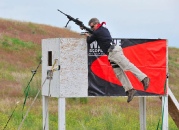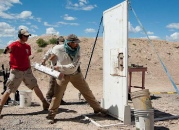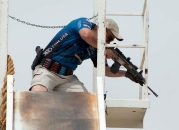Father and Son Win Big at 2016 MGM Ironman Event

The 20th Annual MGM Ironman Match was held in Parma, Idaho earlier this month. Over 250 shooters vied for honors at this ultra-challenging event. The “OLHOT” (Open, Limited, Heavy Optics, and Trooper) classes competed June 5-7, while a Scoped Tactical Match followed June 9-11. Present were top pros, privateers, juniors, ladies, plus elite military and LEO teams. This very demanding 3-Gun event features ten tough, high-round count stages, including a signature zip-line descent from a tower. Without question, the MGM Ironman is one of the toughest shooting matches on the planet.
Watch POV view of the Zipline Stage at 2016 MGM Ironman:
Father and Son Duo Dominates 2016 Event
This year’s OLHOT match was definitely a “family affair” for the Gibson clan. In the Trooper Division, 17-year-old Wyatt Gibson won convincingly, finishing 138 points ahead of the next-best shooter. Meanwhile Wyatt’s father Travis Gibson won the Open Division. In true ‘Like father, like son’ fashion, Travis dominated the Open field, finishing 121 points ahead of his closest Open-class competitor.

This year’s aptly-named Ironman was particularly tough with triple-digit temps and strong winds. Over the course of three grueling days, competitors completed ten tough stages, shooting in excess of 1100 rounds per shooter over the course of the match. EVERY stage required the use of ALL three guns with 100 or more rounds. The average time spent shooting on each stage was about seven minutes. The Ironman is long, intense, and you shoot till you drop! Mike Gibson, the founder of MGM Targets, and the “inventor” of the Ironman, has said: “This match isn’t for weenies or crybabies”.
The week-long Ironman event is broken into two, 3-day sessions, with five different divisions. The OLHOT (Open, Limited, Heavy Optics, and Trooper) sessions ran June 5-7. During the second segment, held June 9-11, 120 Scoped Tactical shooters took on the same demanding course.

 MGM Ironman Has Unique Stage Designs
MGM Ironman Has Unique Stage Designs
The MGM Ironman is an intense test of both shooter and equipment. Participants shoot a variety of classes and various scenarios including shooting from the back of a moving vehicle, from a 20-foot tower, while driving a golf cart, and while carrying a dummy.
Of course there are plenty of MGM-made reactive targets (photo right). The MGM Ironman regularly offers unique and demanding stages including firing a pistol from a zip line, and plunging down a steep slide from a 30 foot tower, rifle in hand. One stage involves carrying an 80-lb dummy over 100 feet and lifting it to the top of a six-foot platform before climbing it to engage rifle targets at distance. With creative and challenging stage designs and high round counts, he Ironman is truly a unique match.

Here is a video from the 2010 MGM Ironman. It shows many of the multi-gun stages, including the Zipline stage, filmed from multiple camera angles.


























